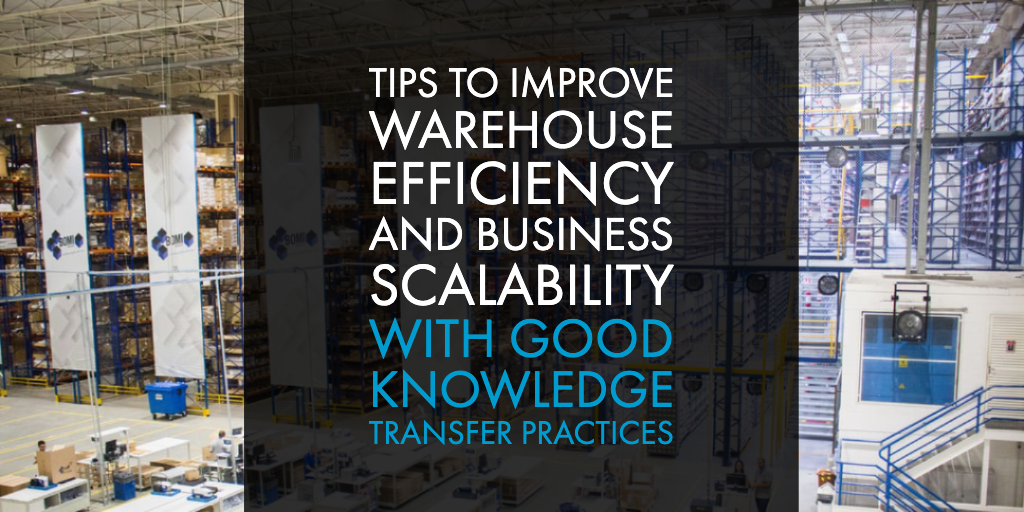Whether you are a startup shooting for the stars or an existing company ready to make a transformation with smarter growth, you need a plan if your goal is expanding your business. Without a proper plan for business scalability, you are going to struggle--starting with warehousing and distribution. You want to have inventory both in stock and ready to efficiently distribute at an economical rate. Therefore, you have to take into account both the long-term, big-picture goals and the steps to get you there. Here are some ways you can improve warehouse efficiency and scale your business while following good knowledge transfer practices.
Start With Smart Scalability
“Growth is awesome,” says Todd Gibby in Inc. “This is true in any business setting, but particularly so in an early-stage environment.” As you start out with a plan in place you are more capable of keeping the growth going in the right direction. The Inc. article continues to point out you want to have a combination of situation-specific details and big-picture strategy. In terms of warehouse operations, you can start by having a plan for optimizing the existing space you have available.
From Supply Management's Five Simple Ways to Improve Warehouse Efficiency, here is a big-picture strategy concept followed by actions specific to that strategy. Because while it is great to have a broad scope goal, you also want to have actionable steps to take that streamline your team toward the end line. And of a big-picture strategy for warehouse efficiency:
- Maximize traffic flow within the warehouse to increase productivity and efficiency on order fulfillment to move more product faster and gain in ROI.
Now take a look at the specific steps necessary for expanding on the big-picture strategy:
- Add shelving to maximize vertical space and increase traffic flow on the floor
- Upgrade forklift equipment for faster speeds and greater lift capabilities
- Pallet wrapping equipment with more economical and/or efficient supplies
If you are trying to do this more environmentally sound, you would tailor those steps as such:
- Implement shelving made from recycled materials
- Choose electronic and battery-powered forklifts that give off zero emissions
- Use 100 percent recycled and repurposed wooden pallets
Ultimately, it will be your employees who put these plans into motion for your company. By having a plan that has detailed information, as well as an end goal and big-picture insight, you offer transparency to your team. This is what they need to be able to achieve their end goals of helping your company achieve scalable growth. The alternative is to simply say you want the company to increase the total ROI of $500,000 by the end of the year through a more efficient warehouse. This leaves the team in the lurch from Day One.
Optimize Warehouse Training
In the warehouse, you typically provide training on the spot or as needed. In addition, training is provided with onboarding and orientation when you hire new employees. There should be more training than that. Forbes contributor Chris Cancialosi points out that you want to offer formal training whenever feasible. However, if you are an SMB or just a startup, you may lack the resources, technology, or staffing to provide ongoing in-house formal training.
In that case, Cancialosi suggests doing simulations or tests. This is similar to business continuity plan testing where you perform mock scenarios. Here for warehousing simulations for the forklift example we are running with, consider renting a variety of forklifts for test-runs. Utilize each make/model for the same period. Maintain data either electronically and/or manually. Test for fuel use, cost of use, cost of maintenance, and time spent onboarding with each machine.
This is a mock run with the equipment but only the first of many simulations. Once you have a forklift selected, provide training in-house for the new machine. Then continue offering safety and speed training by setting up simulations. These simulations can include:
- A forklift is malfunctioning during the busy time for the warehouse to test for speed of maintenance and repairs
- Someone is involved in a forklift accident to test for how quickly medical services are provided and the time it takes to follow the steps to take in reporting this to OSHA for proper regulatory compliance
Take a big-picture look at the potential for risks and accidents that could occur in the warehouse as your company scales up.
Obtain Accurate Information
You are also tasked with maintaining accurate data in terms of both inventory and warehousing practices. This means having a system in place so that you can transmit information and communicate effectively in real time. Provide your business with point-of-need information they require to do their jobs efficiently. This enables your business to scale operations successfully so you can continue to grow and expand. You also gain the data that you need to evaluate for end-of-the-year reports, which ensures you can properly determine whether you have been scaling up successfully throughout the course of the business year. From here you have the tools to continue with proper scaling with warehouse efficiency front and center in the future.
Looking for more advice? We're here to help.





Leave a comment